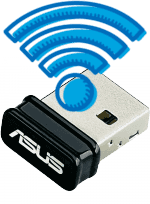Setup Wi-Fi Adapter and Configure Wireless Interface

I’ll show an example of how to configure a connection to a wireless network from the console of the Debian system by using Wi-Fi Adapter “ASUS USB-N10 Nano” (ID: 0b05:17ba, Driver: rtl8192cu).
Installing driver/firmware for Wi-Fi Adapter
Wi-Fi Adapter “ASUS USB-N10 Nano” is uses the driver “rtl8192cu”, wich can be found in the firmware-realtek package.
1. Add a non-free component to /etc/apt/sources.list, for example:
# Debian 7 "Wheezy" deb http://http.debian.net/debian/ wheezy main contrib non-free
2. Update the list of available packages and install the firmware-realtek package:
sudo apt-get update
sudo apt-get install firmware-realtek
3. Connect the device to your system.
Now the adapter is setuped.
Scaning Networks
Scan for available networks and get network details:
sudo iwlist scan
Configure Wireless Interface
1. We are going to connect to the wireless network with WPA-PSK/WPA2-PSK authentication method, so before continuing, we need to install the wpasupplicant package:
sudo apt-get install wpasupplicant
2. Restrict the permissions of /etc/network/interfaces, to prevent pre-shared key (PSK) disclosure:
sudo chmod 0600 /etc/network/interfaces
3. Open /etc/network/interfaces in a text editor:
sudo nano /etc/network/interfaces
Then append the define appropriate stanzas for your wireless interface, along with the SSID and PSK. For example:
# WiFi auto wlan0 iface wlan0 inet dhcp wpa-ssid NNNN wpa-psk NNNN
The auto stanza will bring your interface up at system startup.
- wpa-ssid - your wifi name
- wpa-psk - your wifi password
4. We can now bring our interface up and down with the usual ifup and ifdown commands:
sudo ifup wlan0
This will start wpa_supplicant as a background process.
If you added auto wlan0 as in the example above, the interface should be brought up automatically during boot up.
If this article has helped you then please leave a comment ![]()
Thanks for reading!
Arthur is a designer and full stack software engineer. He is the founder of Space X-Chimp and the blog My Cyber Universe. His personal website can be found at arthurgareginyan.com.


